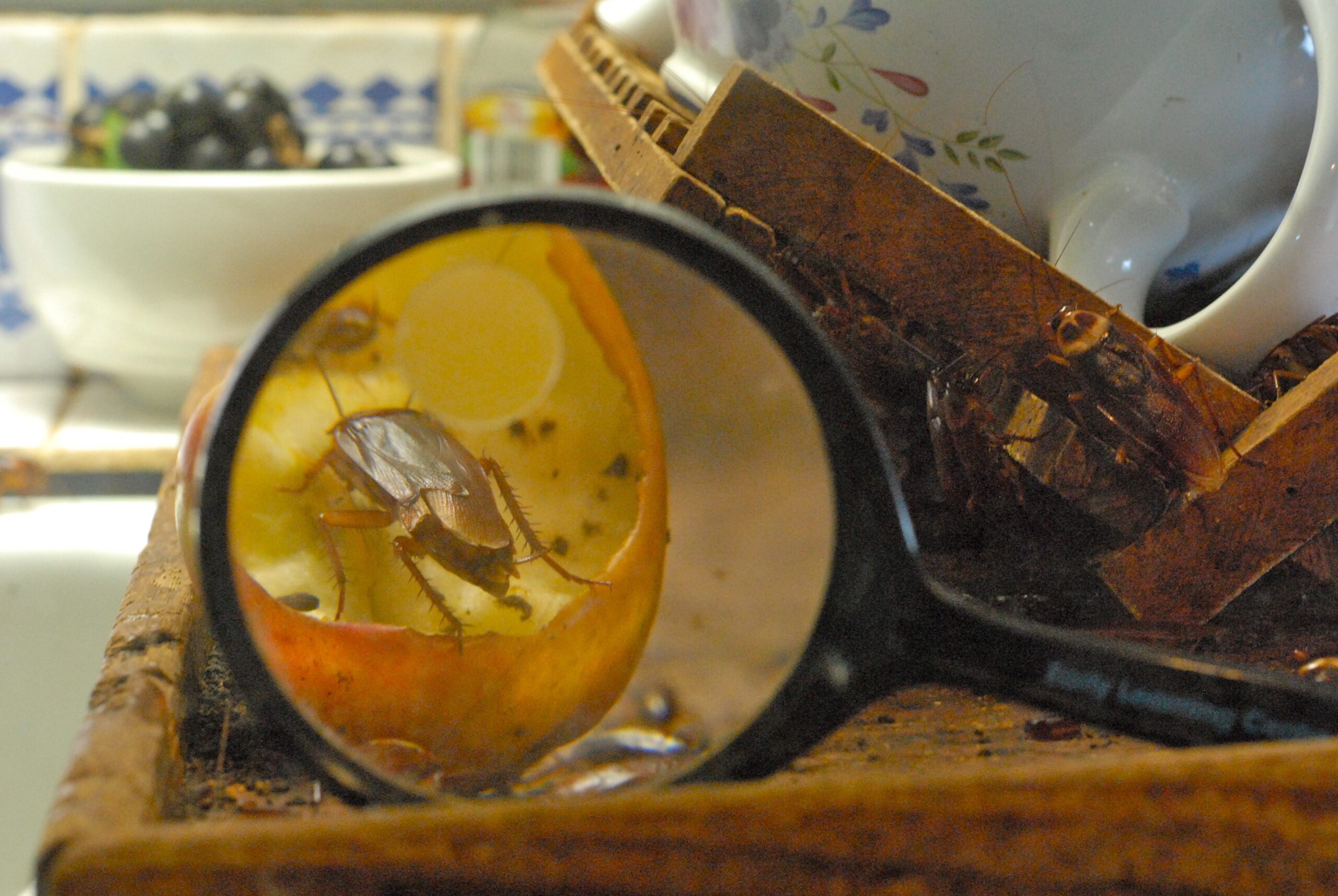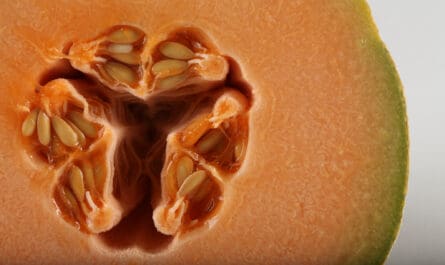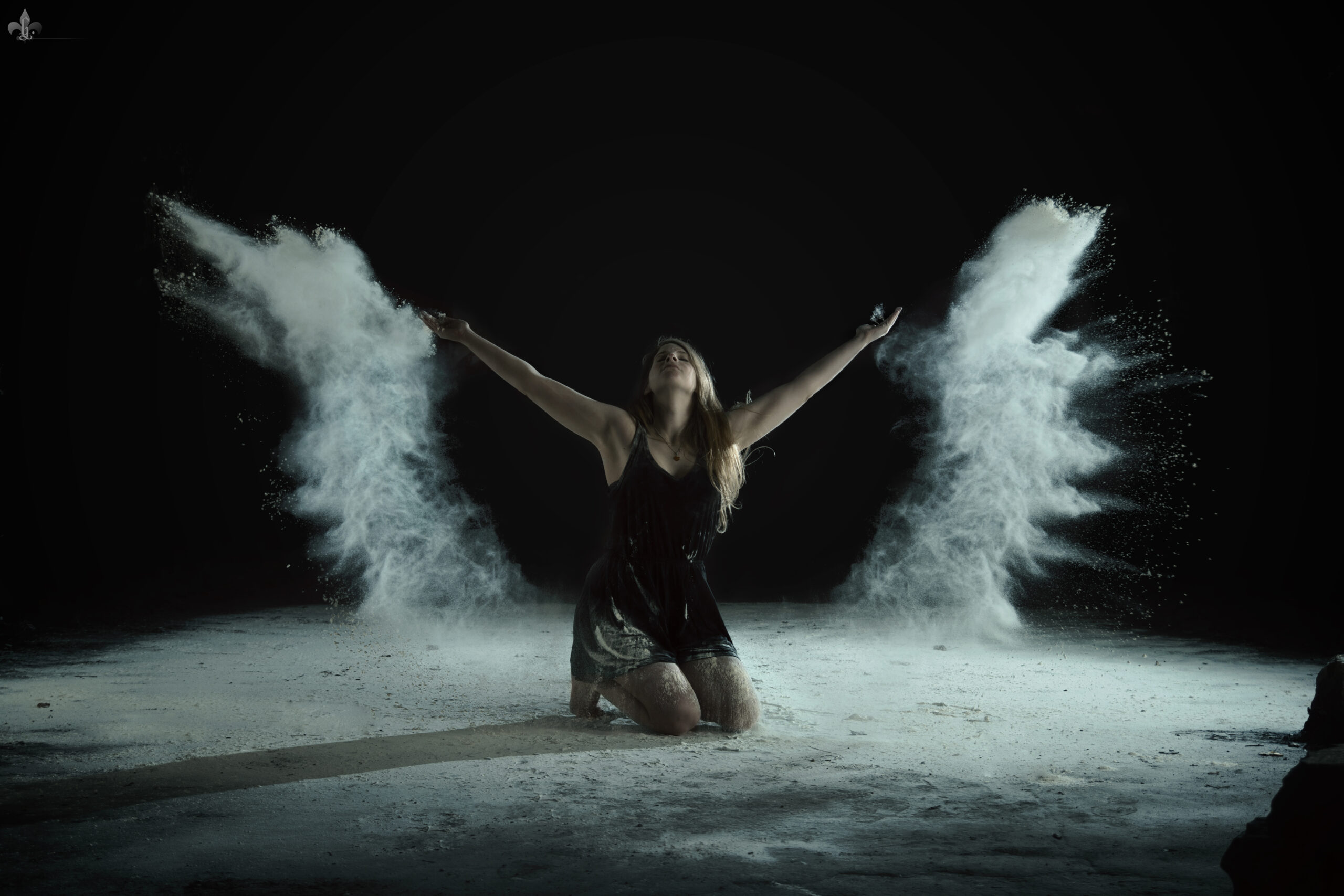The first cockroach appeared during a tour for prospective graduate students. Being a laser lab, we had turned the lights out and configured exhibitions of several flashy phenomena of which the laser was capable, despite their being incidental to our actual science. With dark-adjusted eyes and a deep familiarity with the crenellations of apparatus on the laser table I was able to recognize the insect, imprison it under an overturned beaker, and, before they could pick out the intruder, block it from the view of my audience of students. Delight at the potential of the instruments was slowly eroding their hangover-induced apathy, but an errant pest could instantly resolidify it. Once the students had been escorted through the basement warren of hallways to their next lab, I went to remove the cockroach, assuming it would skitter as soon as I moved the beaker. Instead, it lay still, antennae barely twitching as I slid the beaker to the edge of the table and toppled it into a waste basket. For a tombstone I dropped an old chemical catalog the size and weight of an unabridged dictionary after it.
Perched on the tip of engineering possibilities, cutting-edge laser systems are mercurial beasts, skittish around noise (their senses extending to electricity and magnetism in addition to a wider sweep of the pressure waves and vibrations that we perceive as sound), persnickety regarding their comfort and sustenance. They are often hypochondriacs, requiring extensive coddling to coax them into even minimal levels of acceptable function. Because of this disposition, laser labs are situated in basements, surrounded by the most sophisticated air-handling that can be afforded by the overlap of scientific desires, administrative budgets, and engineering pragmatism. In a narrow room behind the entire back wall of our lab squatted two enormous air handlers, laboring to keep the temperature and humidity of our lab at constant levels. From this room another door led back to the mysterious labyrinth of steam tunnels, maintenance passages that carried the vital fluids for building operation (water in both its liquid and gaseous states, electricity, networking) from unknown sources to our building. The very name conjured ideas of humid, fetid caves, an underground jungle in which cockroaches would be as common as the CAUTION: HOT signs on the pipes, but we never ventured into them.
After that first oddly sedate cockroach crashed our tour, they started appearing in the lab, singly, every few weeks, usually in proximity to the door to the air handler space. When the lights came on, they’d make their slow way towards the nearest shadow, teetering like a wind-up toy. Left alone, they would be found dead a day later. Sometimes they were already dead when we first saw them. We swept them all into the trash.
Laser labs are often kept dark, partly to keep room lights from interfering with the signals one is trying to detect, but also to permit users to more easily discern the photons they are coaxing into generating results from the surrounding incoherent blaze. This darkness is purportedly comfortable to cockroaches; our multi-million-dollar basement laser lab apparently no different than the other subsurface rooms adopted by these inquilinous insects as an improvement on rotting logs. Cockroaches can see ultraviolet and most visible light but not red or infrared. They see in color. Most live about a year. Procrastinating graduate students with access to hundreds of journals and unfocused curiosity quickly sussed out these relevant details. Typically, ultraviolet light produces a startle response. Our cockroaches did not startle. They gave every impression of being elderly. We devised and refined experiments to investigate these claims but did not undertake them. Apocryphal accounts of senilicide were mentioned, jokingly. The spectrum of our lab being oversaturated in the ultraviolet, thanks to our lasers, it would be a remarkable place to anything that could see it. A suitably phantasmagoric landscape in which to embrace eternity. A blacklight expo in Las Vegas on the fourth of July. The aurora borealis imprisoned beneath classrooms, offices, and a snack bar.
The cockroaches didn’t appear with sufficient regularity or in large enough number for us to fear an infestation. They were endemic to steam tunnels, we assumed. The presence of a few lurching stragglers wasn’t worth giving up eating at our desks. Seeing one on a ramble through the lab, our advisor tasked a student with contacting the facilities department about them. The task, like many unrelated to our own projects, was passed from graduate student to graduate student over the course of months until it was forgotten.
Summer came and with it midwestern humidity and the need to finesse the air handlers, provided with two targets (temperature and relative humidity) and one lever (temperature). The resulting sine wave of algorithmic futility could swing parts of the room eight degrees every twenty minutes (we measured and produced graphs, natch), driving our lasers into sputtering derangement. We found ourselves making frequent trips to the air handler room to make adjustments the only effects of which were to assuage our desire to have a sense of control over the lasers. There we began to notice odd little piles of unidentifiable detritus near the lab door. Smaller than the amalgamations of hair and dust that often lurk in the crevices of human habitation, these gave the impression that they had been placed. Soon we noticed small crumbs of ramen, single peanut halves, and fragments of snack chips left in tidy piles near the door. Sometimes nail shards or other insect carcasses would be included in the piles. Two or three piles might appear at once, separated by a few centimeters.
Baroque eddies from the overworked air handlers, pack rats, mentally unhinged graduate students—we sorted the possibilities. The piles continued to appear in the air handler room, along with the doddering cockroaches in the lab proper. We swept everything into the trash. The cockroaches we found in the lab were usually larger, slow moving, creaky. This wasn’t typical cockroach behavior. We worried about vague toxins. We spent enormous amounts of time in the lab; should we be worried? An intrepid student ventured into the steam tunnels, reporting a few smaller cockroaches that fled from her light when she turned it on and indignantly waved their antennae at her from their refuge under the pipes.
Finally, our advisor prevailed, or a student caved and called facilities. We paused our experiments to let a parade of workers and exterminators traipse through to poke in the corners of the lab and deposit caches of poison. We grumpily agreed to store and consume our food only in the shared graduate student office space that smelled continually of microwaved fish.
Still the piles and corpses appeared.
Late one night, thirteen hours into an experiment, I wandered into the air handler room, not because I needed to adjust anything (the laser, once appeased, could run for hours and students had learned to take advantage of such periods of cooperation and collect as much data as they could before the inevitable breakdown), but just to keep myself alert. I made several trips there, walking laps in the lab, close enough to keep an eye on my data, but long enough to keep my body from remembering it should be sleeping. Opening the door to the air handler space, I saw a cockroach scurry under the door to the steam tunnels. A tiny piece of cookie sat next to the wall. I assumed the cockroach had been heading to collect the food, but midway through my next round I remembered that the space had been swept out that morning and I hadn’t noticed any crumbs on my previous visits. Over the next few hours I saw the cookie crumb gain companions: half a millipede, a tiny orange corner of Dorito, a curl of ramen, a citrus pip. Two more times I saw cockroaches, different ones based on their size, rise on their legs and skim towards the steam tunnel.
When I came back after a day of sleep someone had swept up the pile.
The piles didn’t grow larger, only more numerous. We recognized a taxonomy: one always had cookie crumbs but no hair, another millipede parts and bread, a third only ramen. More exterminators visited. Dutifully, we teased data out of the laser and swept.
Another late night, this time fighting with the laser for data I desperately needed for a presentation (and, not insignificantly, eventually to graduate). As the air temperature dropped yet again, I stalked back to the air handler to shut the humidity control off, my body vibrating with enough exhausted rage to discomfit the laser. Entering the air handler room, I caught one of the decrepit cockroaches crossing from the steam tunnel door to the lab. I waited until it cleared the sweep of the steam tunnel door, then slowly opened it so I could viciously kick the cockroach back into the tunnel to die there. Near the back wall of the tunnel a cluster of cockroaches of all sizes huddled facing the door. They didn’t startle at the influx of light, but sat, their antennae waving an unintelligible message at me or their departing relative. I closed the door, cautiously stepped over the laboring exile, and returned to work, forgetting about the humidity control. The next day I swept up the corpse of the exiled cockroach and on behalf of the universe accepted the pile of offerings left by its family.
Words assembled by Patrick M. Hare have appeared in The Stirling Spoon, Vestal Review, and Photochemistry and Photobiology. They are mostly good words and only a few are made up. He lives near Cincinnati, OH but can be found on twitter @nkupmh.




